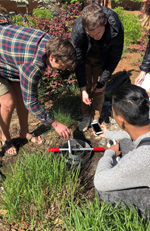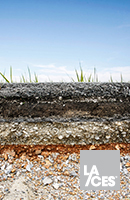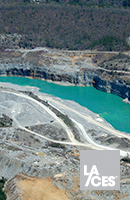Learn
Landscape Architecture Technical Information Series (LATIS) Descriptions
LATIS papers provide practicing landscape architects with technical information about new and evolving practices and products. ASLA members can download LATIS papers for FREE! Just click the LATIS paper title below, add the free papers to your cart, and check out.
A Landscape Performance + Metrics Primer for Landscape Architects: Measuring Landscape Performance on the Ground (2018)

by Emily McCoy, ASLA
Complete the exam to earn:
3.0 PDH (LA CES/HSW)
3.0 SITES-specific GBCI CE (GBCI course ID 0920018252)
Landscape architecture is at a pivotal moment in its history as a discipline, where design practice is becoming more reflective, adaptive, and scholarly. As the need for sustainable design grows, it has become imperative that professionals put their work under analytical review and set higher standards for their work to perform environmentally, socially, and economically. The field looks more to the integration of research and scholarly inquiry in design as a solution to this growing need for high-performance landscapes. While the concept of landscape performance assessment is gaining attention within the field, the availability of time, resources, and technical expertise remains an obstacle for many designers in evaluating built work. More in-depth research investigations are best left to academics and scientists, but methods exist that every landscape architect can use to assess the performance of their own work for use throughout the planning, design, construction, and post-occupancy phases. This paper aims to provide an introduction to these metrics and methods that can be applied in the field.
Suburban Street Stormwater Retrofitting: An Introduction to Improving Residential Rights-of-Way (2015)

by Andrew Fox, ASLA, PLA; Jim Cooper, ASLA, PWS
Complete the exam to earn: 1.5 PDH (LA CES/HSW)
This LATIS introduces readers to design and implementation strategies for stormwater retrofitting within suburban street rights-of-way. Street stormwater retrofitting is a green street design approach that embraces low impact development (LID) principles to treat stormwater runoff within the paved areas of existing roadways. In essence, street stormwater retrofits mimic the function of natural systems to mitigate the potentially harmful effects to water and air quality that streets can present. Depending upon their extent within the built environment, street stormwater retrofits can perform these functions across a variety of scales and have the potential to greatly affect positive environmental change when implemented across large areas. In addition to promoting responsible and healthy stormwater management practices, these green infrastructure amenities offer residential communities a wide array of benefits including neighborhood beautification, vehicular traffic calming, and pedestrian and bicycle safety.
Integrating BIM Technology into Landscape Architecture, 2nd Edition (2014)

by James L. Sipes, ASLA
Complete the exam to earn: 3.0 PDH (LA CES/HSW)
This LATIS addresses Building Information Modeling (BIM). BIM provides a digital representation of the physical and functional characteristics of a facility. It allows the creation of detailed 3D models that can simplify the process of designing complex spaces. While BIM currently is used primarily in the building industry, it can be employed in many other disciplines, including landscape architecture. The LATIS discusses how BIM works, current applications and projects, and how it can be adapted to a variety of sites. It provides practical information on how landscape architects can adapt BIM to fit their specific needs.
Wayfinding: Principles and Practice, 2nd Edition (2013)

by David Raphael, ASLA
Complete the exam to earn: 2.0 PDH (LA CES/HSW)
David Raphael, ASLA, provides landscape architects with concepts and tools for planning, designing, and implementing wayfinding and public information systems. Topics include the origins of wayfinding, its components, human factors, the design process, recent innovations, and a sampling of wayfinding systems. Attention is given to the skills that landscape architects bring to the process of designing these systems. Throughout the publication, photographs and other images illustrate and reinforce the concepts presented.
Planting Soils for Landscape Architectural Projects (2013)

by Barrett L. Kays, FASLA
Complete the exam to earn: 3.0 PDH (LA CES/HSW)
This technical manual, written by Barrett L. Kays, FASLA, teaches and demonstrates how to apply modern soil science techniques to create the best possible soils for landscape plants and the environment. The manual presents important soil concepts and how they should be applied to the design of soils for both small and large landscape architectural projects. The publication is intended as a resource for independent study and to improve landscape architects’ understanding of soils and how to effectively manage soils on their projects.
Forum on Therapeutic Garden Design (2011)

by Marni Barnes, ASLA; Jack Carman, FASLA; Nancy Carman; Nancy Chambers; Clare Cooper Marcus, Honorary ASLA; Nilda G. Cosco, Affiliate ASLA; Mark Epstein, ASLA; Sonja Johansson, FASLA; Jean Stephans Kavanagh, FASLA; Don Luymes; Patrick F. Mooney, ASLA; and Robin C. Moore, Affiliate ASLA
Complete the exam to earn: 3.5 PDH (LA CES/HSW)
The LATIS Forum on Therapeutic Landscapes discusses the practice of creating landscapes to support human health and well-being. Authors explore how this practice area, rooted deeply in tradition, is evolving to meet modern needs arising from various life circumstances. Successful designs and the process to create them vary according to the special needs of user groups. Readers will learn how therapeutic landscapes provide benefits to all humans, both in clinical and institutional settings and in the matrix of everyday life.
Reclamation Planning of Pits and Quarries, 2nd Edition (2010)

by Anthony Bauer, FASLA; Robert E. Ford, ASLA
Complete the exam to earn: 3.0 PDH (LA CES/HSW)
This LATIS is an introduction to mining and reclamation practices of the construction aggregate industry. Aggregate mining offers professional opportunities as well as challenges for the landscape architect. The paper describes planning procedures and techniques for reclaiming mined land and gives general guidelines for those interested in this area of professional practice. Case studies of several successful reclamation projects provide and overview of the wide range of development options made possible by the mining and reclamation of land.
Geographic Information Systems: Using the Tools for Informed Growth, 2nd Edition (2010)

by Karen Hanna, FASLA
Complete the exam to earn: 1.5 PDH (LA CES/HSW)
Karen Hanna, FASLA, reveals ways to identify appropriate existing datasets and use them as a baseline for recording current and prospective site conditions and uses. GIS techniques promote application of sophisticated scientific models to the landscape, and combine effectively with other digital technologies such as graphs and photo simulations. The results of GIS models are eminently useful for site planning, growth planning, and implementation phasing.
Successful Ecological Restoration: A Framework for Planning/Design Professionals (2008)

by Lee R. Skabelund, ASLA; G.M. Kondolf; Craig Johnson, ASLA; and Allegra Bukojemsky, ASLA
Complete the exam to earn: 3.0 PDH (LA CES/HSW)
This publication presents the principles of ecological restoration, with a focus on how landscape architects can incorporate these principles into their projects, and how they can work with scientists to meet ecological restoration project goals. The importance of collaboration between designers, planners, scientists, and stakeholders in such projects is emphasized. An extensive resource list provides project examples from different ecosystems and regions of the U.S.
Green Roof Infrastructure (2007)

by Steven Peck, Honorary ASLA
Complete the exam to earn: 3.0 PDH (LA CES/HSW)
Steven Peck, Honorary ASLA, of Green Roofs for Healthy Cities, discusses the history, benefits, design, construction, and maintenance of green roofs. The publication also provides a series of project profiles, illustrating award-winning green roofs across North America. An expanded project profile also gives insight to the development of ASLA’s green roof.